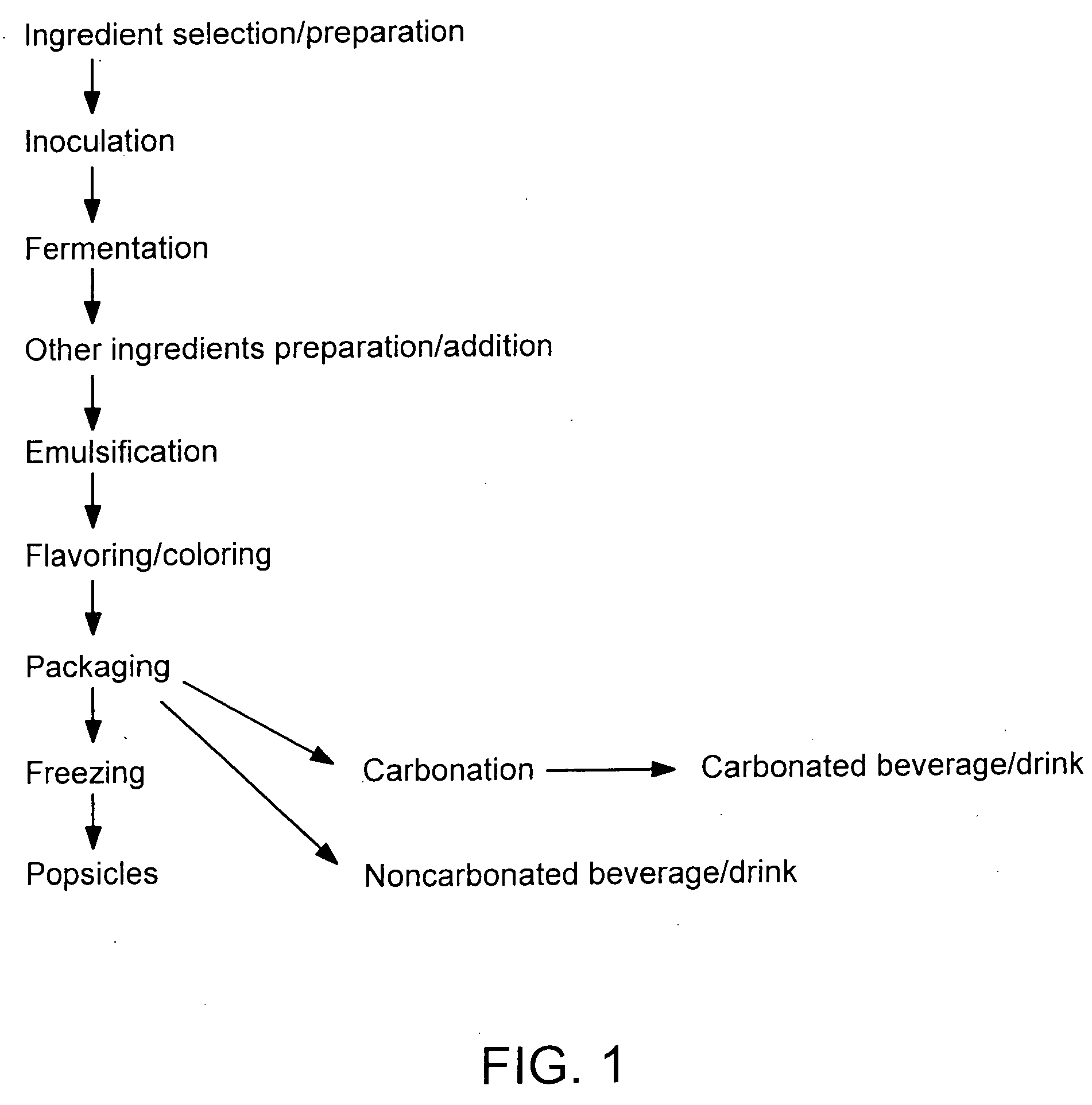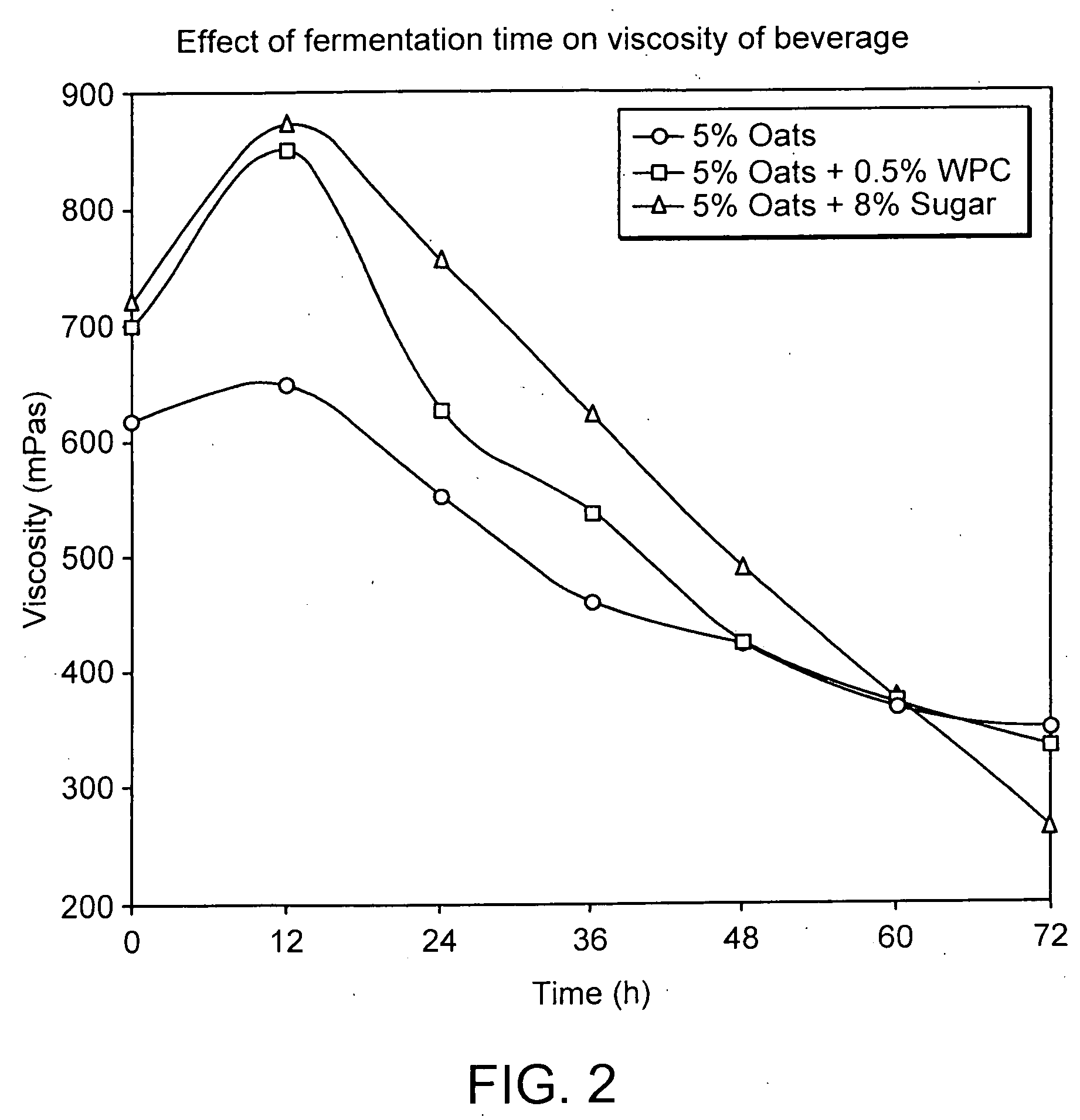Symbiotic food products comprising oats and methods for manufacturing the same
a technology of oats and food products, applied in the field of symbiotic food products, can solve the problems of reducing the number of organisms in the intestine, premature destruction of fibers during the preparation and storage of products, and varying degrees of digestive problems, and achieve the effect of inhibiting growth
- Summary
- Abstract
- Description
- Claims
- Application Information
AI Technical Summary
Benefits of technology
Problems solved by technology
Method used
Image
Examples
example 1
Manufacturing Scheme for Symbiotic Dairy Products
[0060] The following describes an exemplary manufacturing scheme for preparing a symbiotic dairy product according to one aspect of the invention.
Ingredient Preparation
[0061] The following ingredients are selected for a symbiotic yogurt beverage: 2% fat pasteurized milk; Grade A nonfat dry milk; natural pectin or locust bean gum; inulin or oligofructose; a L. acidophilus starter culture; commercial Bifidobacterium spp. Other minor ingredients may also be provided.
[0062] Fermentation:
[0063] Pasteurized milk or reconstituted nonfat dry milk (10%, w / v) is fortified with inulin or oligofructose at 0% or 3%. The mix is heated to 75° C. for 5 minutes and cooled to 43° C. before inoculating the probiotic cultures. The mix is incubated at 43° C. for 4-6 hours or until pH of about 4.5 is achieved.
[0064] Formulation and Homogenization:
[0065] The symbiotic yogurt is formulated by using 40% of the yogurt base described above, 0.2% stabiliz...
example 2
Oat-Based Symbiotic Beverage
[0095] The objectives of this study were to optimize the fermentation conditions to develop a beverage using probiotics and oats with acceptable sensory and nutritional qualities.
[0096] Oats, skim milk powder (SMP), sugar, whey protein concentrate (WPC) were used for the formulation. The formulated mix was fermented using L. plantarum (B28), L. casei ssp pseudoplantarum (B29) and L. acidophilus.
[0097] Changes in pH, titratable acidity (TA), viscosity and growth of cultures were determined for three prototypes: a) 5% oats; b) 5% oats+0.5% WPC; and c) 5% oats+8% sugar; samples were taken every 12 h up to 72 h of fermentation at 37° C.
[0098] The results are presented in FIGS. 2, 3, and 4. The probiotic count (108) was maintained throughout the fermentation time. The results indicated that fermenting for 48 h gives an acceptable product with acceptable probiotic count. Prototypes a), b) and c) had viscosity 411, 420 & 407 mPas; pH 4.02, 3.95 and 2.99; TA ...
example 3
Yogurt-Like Oat-Based Symbiotic Product
[0102] This Example describes the production of a yogurt-like fermented oat product.
[0103] Formulation and Production Methods:
[0104] The fermented oat product was formulated using oat flour, sugar, and pre-polymerized whey protein isolate (WPI) as the gelation agent. An oat slurry (5% oat flour, 7% sugars) was sterilized at 120° C. for 15 min. The sterilized oat slurry and polymerized whey proteins were fermented at 43° C. for about 4 h using YoFast 10 commercial starter culture and probiotic mix (Chr. Hansen), which contains Streptococcus thermophilus, L. delbrueckii subsp bulgaricus, L. acidophilus, L. casei, and Bifidobacteria.
[0105] Product Analysis:
[0106] Chemical composition of the prototype product was analyzed for total solids, fat, soluble fiber, insoluble fiber, and ash. Results of this analysis are shown below:
Total solid content10.8% ± 0.1Fat content1.34% ± 0.2Soluble fiber content0.22% ± 0.1Insoluble fiber content0.83% ± 0.3...
PUM
 Login to View More
Login to View More Abstract
Description
Claims
Application Information
 Login to View More
Login to View More - R&D
- Intellectual Property
- Life Sciences
- Materials
- Tech Scout
- Unparalleled Data Quality
- Higher Quality Content
- 60% Fewer Hallucinations
Browse by: Latest US Patents, China's latest patents, Technical Efficacy Thesaurus, Application Domain, Technology Topic, Popular Technical Reports.
© 2025 PatSnap. All rights reserved.Legal|Privacy policy|Modern Slavery Act Transparency Statement|Sitemap|About US| Contact US: help@patsnap.com



